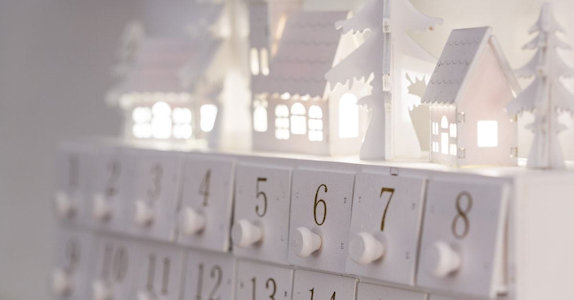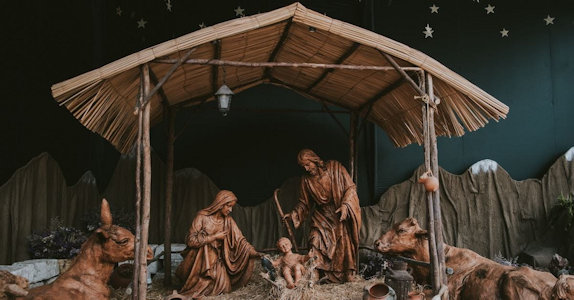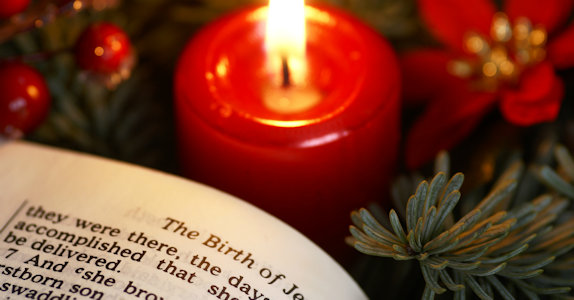The Meaning and History of the Advent Calendar
from christianity.com
by Scott James, November 10, 2020
 The Advent calendar is an ever-present part of the Christmas season. Rooted in a tradition that spans centuries of church history, the modern version of the Advent calendar has been around since the nineteenth century. Emerging from a Protestant Christian context, Advent calendars carry an underlying spiritual message of anticipation and hope. By helping us remember and reflect on the coming of Jesus Christ, Advent calendars can be a valuable aid for Christian families.
The History of the Advent Calendar
The Advent calendar is an ever-present part of the Christmas season. Rooted in a tradition that spans centuries of church history, the modern version of the Advent calendar has been around since the nineteenth century. Emerging from a Protestant Christian context, Advent calendars carry an underlying spiritual message of anticipation and hope. By helping us remember and reflect on the coming of Jesus Christ, Advent calendars can be a valuable aid for Christian families.
The History of the Advent Calendar
 Among the many traditions that have sprung up to accompany the Advent season over the years one of the simplest and most popular is the Advent calendar. Instead of strictly following the four-week Advent period, which can start anywhere from November 27 to December 3, an Advent calendar typically begins on December 1 and counts down the days until Christmas.
Advent calendars now come in many forms, but the tradition began simply enough when German families in the mid-nineteenth century started counting the days until Christmas by tallying chalk marks on a door or wall. Variations of the countdown included lighting a candle or hanging a religious picture for each day leading up to Christmas Eve. Some families began making homemade Advent calendars to accompany their countdown and by the early 1900s, a few publishing companies and newspapers had produced simple printed calendars.
The popularity of Advent calendars spread with the help of a German printer named Gerhard Lang. Having grown up with a homemade calendar, Lang began designing cardboard Advent calendars around the turn of the century and, later in the 1920s, came up with the idea of cutting out little doors that could be opened each day. Behind each door, a devotional picture or Bible verse was hidden. With this innovation, Lang is considered the father of the modern Advent calendar.
Paper rationing during World War II halted the production of Advent calendars for a time. With the resolution of the war, a few printing companies revived the tradition, and the calendars began to catch on once again. Their popularity in America was boosted by images of President Dwight Eisenhower opening an Advent calendar with his grandchildren in the 1950s. By that time, many calendars began including simple gifts, such as chocolate or a small toy, behind each door. Since then, the popularity of Advent calendars has continued to grow, even crossing over into non-religious contexts.
The Meaning Behind the Advent Calendar
Among the many traditions that have sprung up to accompany the Advent season over the years one of the simplest and most popular is the Advent calendar. Instead of strictly following the four-week Advent period, which can start anywhere from November 27 to December 3, an Advent calendar typically begins on December 1 and counts down the days until Christmas.
Advent calendars now come in many forms, but the tradition began simply enough when German families in the mid-nineteenth century started counting the days until Christmas by tallying chalk marks on a door or wall. Variations of the countdown included lighting a candle or hanging a religious picture for each day leading up to Christmas Eve. Some families began making homemade Advent calendars to accompany their countdown and by the early 1900s, a few publishing companies and newspapers had produced simple printed calendars.
The popularity of Advent calendars spread with the help of a German printer named Gerhard Lang. Having grown up with a homemade calendar, Lang began designing cardboard Advent calendars around the turn of the century and, later in the 1920s, came up with the idea of cutting out little doors that could be opened each day. Behind each door, a devotional picture or Bible verse was hidden. With this innovation, Lang is considered the father of the modern Advent calendar.
Paper rationing during World War II halted the production of Advent calendars for a time. With the resolution of the war, a few printing companies revived the tradition, and the calendars began to catch on once again. Their popularity in America was boosted by images of President Dwight Eisenhower opening an Advent calendar with his grandchildren in the 1950s. By that time, many calendars began including simple gifts, such as chocolate or a small toy, behind each door. Since then, the popularity of Advent calendars has continued to grow, even crossing over into non-religious contexts.
The Meaning Behind the Advent Calendar While many outside the Christian tradition enjoy their yearly countdown calendar (and its hidden treats), the meaning behind the Advent calendar remains steeped in religious themes. More than just a countdown, marking the days of Advent serves as a time of spiritual reflection and preparation. Advent is a season of waiting, calling to mind the longing and anticipation of God’s people who, for centuries, awaited the coming Messiah.
Counting down the days of Advent can help us consider what it must have been like waiting for the promised Messiah, generation after generation. It gives us an opportunity to lament the reason we needed a savior to come in the first place—our sin—and also to remember God’s past faithfulness to us. On this side of the cross, we know that Israel’s long season of expectation culminated in the birth of Jesus Christ. Likewise, our yearly season of Advent culminates in the celebration of Christmas; but first we walk through a season in which we prepare for the feast.
In addition to commemorating God’s faithfulness in the past, keeping Advent also helps us look ahead with hopeful anticipation. Advent puts us in the habit of watching and waiting, which is a helpful practice because Christians still live in a state of anticipation: We are waiting for Christ’s return. By looking back at His first Advent, we prepare ourselves to live in joyful expectation of His second Advent. By keeping these themes in mind, something as simple as an Advent calendar can help ready our hearts to celebrate the gift of God’s Son.
How to Use an Advent Calendar with your Family
There are many unique styles of Advent calendars. Some are overtly Christian while others play to the more secularized and generic aspects of the holiday season. For families who want to keep their focus on Christ during the Christmas season, using a nativity-themed Advent calendar is an excellent choice. Other calendars highlight Bible stories that tell the history of God’s people leading up to Jesus. The spiritual focus of these Advent calendars is built right into the countdown, often in the form of short written devotionals that accompany the calendar. These types of calendars are an easy way to help families start an edifying Advent tradition.
While Christian-themed Advent calendars can be a helpful tool, many families are able to keep the focus on Christ while counting down with a calendar that doesn’t feature an overtly religious design. These calendars simply facilitate the countdown, leaving it to the parents to be intentional about engaging their family with an Advent-themed devotional. Whether it’s a LEGO countdown kit or a cardboard display filled with chocolate treats, the Advent calendar itself is an object lesson in building anticipation and can be a fun reason to gather the family to create a context for spiritual conversations.
Sample Devotional for an Advent Calendar Day
While many outside the Christian tradition enjoy their yearly countdown calendar (and its hidden treats), the meaning behind the Advent calendar remains steeped in religious themes. More than just a countdown, marking the days of Advent serves as a time of spiritual reflection and preparation. Advent is a season of waiting, calling to mind the longing and anticipation of God’s people who, for centuries, awaited the coming Messiah.
Counting down the days of Advent can help us consider what it must have been like waiting for the promised Messiah, generation after generation. It gives us an opportunity to lament the reason we needed a savior to come in the first place—our sin—and also to remember God’s past faithfulness to us. On this side of the cross, we know that Israel’s long season of expectation culminated in the birth of Jesus Christ. Likewise, our yearly season of Advent culminates in the celebration of Christmas; but first we walk through a season in which we prepare for the feast.
In addition to commemorating God’s faithfulness in the past, keeping Advent also helps us look ahead with hopeful anticipation. Advent puts us in the habit of watching and waiting, which is a helpful practice because Christians still live in a state of anticipation: We are waiting for Christ’s return. By looking back at His first Advent, we prepare ourselves to live in joyful expectation of His second Advent. By keeping these themes in mind, something as simple as an Advent calendar can help ready our hearts to celebrate the gift of God’s Son.
How to Use an Advent Calendar with your Family
There are many unique styles of Advent calendars. Some are overtly Christian while others play to the more secularized and generic aspects of the holiday season. For families who want to keep their focus on Christ during the Christmas season, using a nativity-themed Advent calendar is an excellent choice. Other calendars highlight Bible stories that tell the history of God’s people leading up to Jesus. The spiritual focus of these Advent calendars is built right into the countdown, often in the form of short written devotionals that accompany the calendar. These types of calendars are an easy way to help families start an edifying Advent tradition.
While Christian-themed Advent calendars can be a helpful tool, many families are able to keep the focus on Christ while counting down with a calendar that doesn’t feature an overtly religious design. These calendars simply facilitate the countdown, leaving it to the parents to be intentional about engaging their family with an Advent-themed devotional. Whether it’s a LEGO countdown kit or a cardboard display filled with chocolate treats, the Advent calendar itself is an object lesson in building anticipation and can be a fun reason to gather the family to create a context for spiritual conversations.
Sample Devotional for an Advent Calendar Day
 Similar to the days when early Advent calendars revealed a Bible verse or religious image of some sort, many calendars today are designed with a devotional intent. Each day may include a short Bible passage related to the coming of Christ that can be used for personal reflection or family discipleship. Here’s an example of a brief family devotional that might accompany one of the days of Advent in your home:
Similar to the days when early Advent calendars revealed a Bible verse or religious image of some sort, many calendars today are designed with a devotional intent. Each day may include a short Bible passage related to the coming of Christ that can be used for personal reflection or family discipleship. Here’s an example of a brief family devotional that might accompany one of the days of Advent in your home:
Genesis 3:15
I will put enmity between you and the woman, and between your offspring and her offspring; he shall bruise your head, and you shall bruise his heel. Devotional Thought: Although His perfect creation had just been corrupted by the arrival of sin, God promised that sin and Satan would not have the final victory. The Rescuer would come to crush Satan, ending his rebellion against God. His people may have been under the curse of sin, but God promised them that He would fight for them and win them back to Himself. Questions for Review & Reflection:
•“Enmity” means that two things are against each other. What set God and Satan against each other? (Satan turned against God and then tempted man to do the same.)
•Who does this verse say will defeat Satan in the end? (The offspring of woman; this points to Jesus.)
•How does it make you feel knowing that God has already written the end of the story? (It gives us confidence that God is in control.)
•Christ is our great Victor, defeating an enemy that we never could. Knowing that He intercedes on our behalf, meditate on what this means to you. [This family devotional is adapted from The Expected One: Anticipating All of Jesus in the Advent]
I will put enmity between you and the woman, and between your offspring and her offspring; he shall bruise your head, and you shall bruise his heel. Devotional Thought: Although His perfect creation had just been corrupted by the arrival of sin, God promised that sin and Satan would not have the final victory. The Rescuer would come to crush Satan, ending his rebellion against God. His people may have been under the curse of sin, but God promised them that He would fight for them and win them back to Himself. Questions for Review & Reflection:
•“Enmity” means that two things are against each other. What set God and Satan against each other? (Satan turned against God and then tempted man to do the same.)
•Who does this verse say will defeat Satan in the end? (The offspring of woman; this points to Jesus.)
•How does it make you feel knowing that God has already written the end of the story? (It gives us confidence that God is in control.)
•Christ is our great Victor, defeating an enemy that we never could. Knowing that He intercedes on our behalf, meditate on what this means to you. [This family devotional is adapted from The Expected One: Anticipating All of Jesus in the Advent]